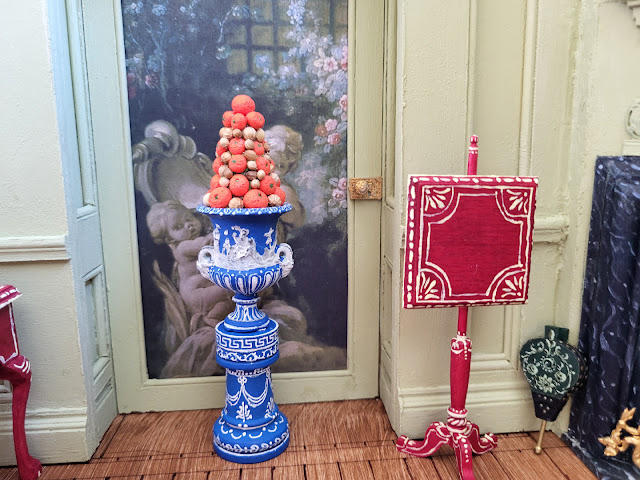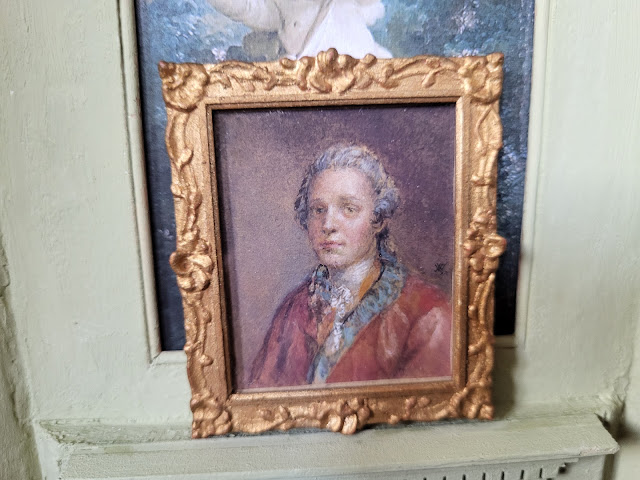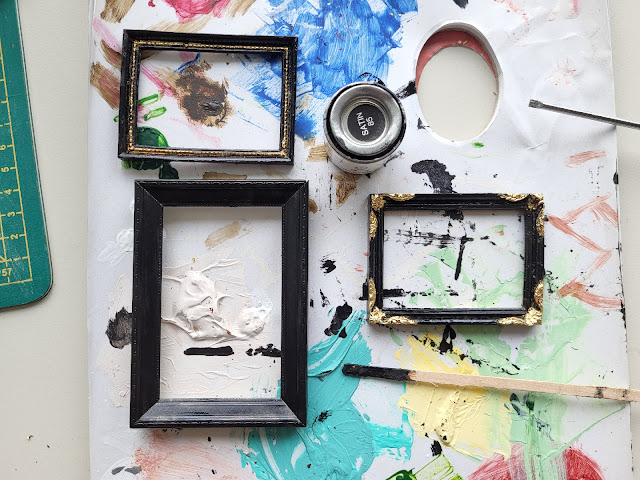Hello my friends,
This is already the fourth post in November. I am certainly catching up on lost time/posts, of the last few months. :-)
This post is a collection of some of the remaining miniatures I still needed to do to finish the dressing room of Belle Zonneschut. In this older picture of the room I have encircled them all in red. Naturally there is always room for more, but after these last bits and pieces I will call this room finished for now and start work in earnest on the Steward's office in the basement of the house.
Why do these last little chores take so long to pick up and finish? O really can't say. Oh well, I have taken them on now. The first little chore was to finally varnish the painted wooden floor. I used a matte varnish because it should not shine like a parquet floor. The main reason for varnishing ofcourse is to protect the paint from scratching due to moving around furniture or the walls of the room.
So what else still needed doing?
The stool for the little wig room:
Like the painted table this stool kit is an old House of Miniatures kit I found on the internet. I rounded off the square cut legs and the corners of the seat to make it fit better to the rounded corners and legs of the table. Next I mixed Hooker's green and titanium white until I got the same light green shade I used on the table and painted the stool with it. It took a few trials of adding a little more green, or a little more white but I finally found the exact tint of green!
The foam seat that came with the kit was quite stiff and somewhat brittle (perhaps due to the age of the kit) and it would not budge under the tightening of the fabric. So to get rounded corners I used a file to get rid of the sharp edges before applying the fabric. The light green fabric is said to be silk but I am not sure if it is real silk. It can be formed when wet so perhaps it is the real deal, but it looks synthetic to me. Synthetic or not, the colour goes very well with the green paint.
When the base coat of paint had dried, I added the decorations in unmixed Hookers's green and titanium white next. And finaly the result of the paintjob can be seen above.
The dressing room curtain:
Here the curtain looks a bit sad, but when I am finished it will look better. I used a piece of the same (synthetic/ silk) fabric I upholstered the green stool with, as a curtain. I made it wet and pushed it in a pretty pleater mat. A pair of Alison Davies doorknobs and a bamboo skewer (all painted gold) for the curtain pole. I've wetted the pleated fabric again a little and tried to drape it over the pole. As you can see it needs some tweeking, still, but this is the curtain I am going with for now.
To make it look a bit better I made a few tassels out of saffron coloured embroidery silk. I hung them on both ends of the pole on different lengths of cord and added some decorative loops of cord before glueing the ends of the cords in place. I glued the ends on the back of the skewer. the rest rests on the curtain or hangs free. This way I can rearrange them if I like to. I guite like the curtain with the loops and tassels. It gives this room a different appearance than the bare window did.
The wig room mirror:
For this mirror I backed a beautiful brass stamped frame with mirror foil after I had "silvered" it with leaf metal. When that was done I hung it on the wall on a cut off dressing pin stuck in the wood. To disguise the pin I threaded a green piece of satin ribbon to make it crinkle. I followed the tutorial in an old Dollshouse Nederland magazine (1997). The tutorial is inspired by the way paintings in Paleis het Loo were hung in the 17th and 18th century.
I fastened it onto the ring on top of the mirror and attached the other end at the top of the pink wall. The bottom end is decorated with a little rozette, crinkled the same way but this time threading not in the middle of the ribbon but to one side. The top end of the ribbon is decorated with a small green glass bead. It surprises me how much more light this frame picks up now that it is silvered, compared to the pretty but dull original colour of the brass.
I have also silvered the brass frame for te standing mirror on the table with the hats. you can see it in its unsilvered state in the top photo. I have already shown you the result of that mirror in my post a few weeks ago. So I will not repeat that here. You will see it again soon when I have refurnished the completed room that I will show you next week.
The framed silhouettes:
I want to hang two framed silhouettes on the back wall of the dressing room. The small strip to the right of the door leading into the powdering room is too narrow to add panels but too wide to leave bare. There is not much that can go there though. These inexpensive resin frames came from 'Action' a cheap store over here with all and sundry at bargain prices. The 'gold' colour is appaling. Nothing like the real stuff, so I gilded them using gold leaf on aplied on gold size.
I have studied several silhouettes. and what I like about the 18th century ones, is that many of those are not just filled in with black ink showing just the silhouette of the person that posed for it. No, in the late 18th century they added several highlights to make the depichted person more recognisable. Somethimes even going so far as to colour the clothes they wore in red or blue or whatever colour to decorate them further. I drew several silhouettes leaving out the wigs, cravattes and such off ink to evoke the look and feel of late 18th century silhouettesl Of the four you see above I chose the lady and the gentleman to go into the small oval frames.
When the gilded frames were cleaned up I stuck the two small silhouettes in the two oval frames and hung them on the dressing room wall next to the door to the wig room. This way the narrow strip of wall has some decoration and is no longer bare. Like I said, it simply was too wide to do nothing with it. These silhouettes could be family members or friends that are dear to Belle's heart.
The other two silhouettes in round frames, an abbot and an officer, will find another place in another room. but that is a subject for another post.
The framed Jonquil embroidery:
This is the beautiful and fine stitchwork of Jonquil which she gave as a present. The photo does not do it justices since it is a little blurred. It is a little work of art with 1722 as a date. And she even has worked my initials HD into it. I feel that it is something prized by Belle Zonneschut. IN 1806 the embroidery already has an age of 83 years. It could be made by a treasured ancestor. And that is why she wants to keep it close to her in the private rooms of her appartment in Huis ter Swinnendael.
So what is needed now, is nail in the wall. Because of the pinks and reds in the embroidery I want it on the wall of the little wig room. And because most of this little room is obscured from view due to the wall and the open door it needs to hang on a spot where it can be seen by anyone viewing this miniature room. I turned the room on its back to hammer a short nail into the woodwork. I am so glad that the walls section is not yet glued to the floor yet! Or to the ceiling for that matter. That would have made that much more difficult. The open door between the two rooms is xixed already and that made this little task already difficult enough.
Foto
Apart from that door it was a simple enough task and went without a hitch. Finally this beautiful gift is hanging on a wall for every visitor to see.
Window seat cushions:
My first venture into the world of sewing and fabrics was this long flat cushion fo the windowseat. The yellow cotton contrasts nicely with the red trim and tassles. But this cusion on its own still makes the windowseat look somewhat bare. And it turned out a bit shorter than intended, so it leaves a bit of a gap left and right. I quite like bolster cushions, so why not make one or two for the windwow seat to dress it up a bit?
To make the bolsters I used the same method as for the one I made for the daybed. I simply cut off two lengths of dowel and rounded off the corners. I made two small red tassels to match the ones on the flat cushion. With th use of a needle I threaded them through two pieces of fabric that go on the short sides of the bolster. I then glued on these bits and cut off the excess. I cut two pieces of yellow cotton to cover the long side and folded over the edges to get a neat edge. I fixed it with glue.
After I glued the fabric on and the glue had dried I added some picquot trim in the same red colour as the tassles for decoration. Et voila!
The stool for the dressing table:
What can I say? The dressingtable also needs a stool. The dressingtable is a second hand. the previous owner had it stripped from its paint or lacquer. The natural wood colour is pretty but in the 18th century simply was not done. It needed a stain at least. Or a paintjob. But with so many painted furniture in the room already I prefer a bit more natural wood for contrast.
I have a bottle of 'antique oak' stain. I applied two coats of it onto the secretaire and on a little unpainted stool. It gives very little colour but it gives the wood a treated look. I quite like that. unfortunately at the same time it does not really hide the different colours in the natural wood. So it does not really unify the pieces together. I leave that for now.
I made a padded seating for this stool using the same green silk as I used on the daybed. It looks a bit plain. So to add some variety and to try out a new technique (for me at least) I added buttons using the tutorial shown by Jodi on her blog "Miniature Madness".
You can find it in the post "Waylaid by faith".
I marked out the position of the buttons on the back of the padded seat and wanted touse the smallest brass coloured beads I could find in my stash. these woul be the buttons but they were so small that the needle would go through their holes. So I abandoned the buttons idea and just used the thread. After some trial and error I ended up with the result as you can see in the picture above. And with that I am very close to calling this miniature room finished. (Miniature rooms are never finished ofcourse, but this one is for now.)
Next week I'll show you the pictures of the finished dressingroom and wig powdering room in all its glory!
Huibrecht






































































